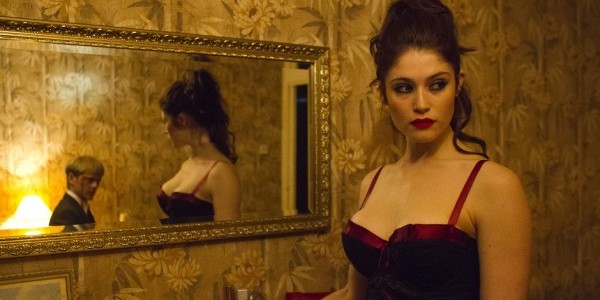Once upon a time Neil Jordan gave the world a grim yet beautiful fairy tale with his nightmarishly elegiac werewolf epic “The Company of Wolves.” With “The Crying Game” he demonstrated his artistic audacity with a mysterious, intensely altruistic love story, one that shocked the world. And then boldly, intrepidly he took the helm of the screen adaptation of one of the most fiercely beloved novels of all time “Interview with the Vampire.” It was a tremendous success, artistically, critically, and financially. Now he has returned to the ever-popular genre of the immortal connoisseur of warm human blood with “Byzantium.”
“My mother tried to murder me, but love confounded her.”
Saoirse Ronan plays the cherubic Eleanor, a blue-eyed immortal who elegantly writes down the tale of her life over and over and over again. With every completion, she tears the pages from her diary, crumples them, and tosses them to the whims of Mother Nature, the eddying breeze, the turbulent sea. In diminutive morsels, her history is told, the lines between memory and the present increasingly blurred. It’s a technique that grants the film an oddly organic time-shifting, dreamlike quality.
Gemma Arterton is Clara, the dominating mother figure with a vicious temper. She is at once kind and loving toward Eleanor, but quickly cold with others manipulating them with a spurious maternal act, and brutal sexuality. She’ll seduce a man as easily as she would behead him, and sometimes the two misdeeds are entwined.
“Byzantium” is, of course, visually fascinating. We would expect nothing less from Neil Jordan. But the film stumbles in its storytelling by repeatedly demonstrating how utterly slapdash two centuries old vampires are when it comes to their eating habits. They often kill in broad daylight and out in the open for anyone to see. Clara is as adept at covering her crimes as some common fledgling killer which begs the question: “How has she lived for so long being so careless?” It’s especially bewildering considering her claims of propensity for preservation throughout the first half of the film.
These vampires don’t sport fangs, itself not an unforgivable crime. They have retractable thumb nails they use for their bloodletting. Under a lesser director, it could have been a silly concept but it generally works here. Aside from this quirk, the film doesn’t tread any new or original territory. The transformation from human to vampire is quite fascinating, but handled dismissively. The intriguing sexual commentary, presenting heterosexuality as a tool utilized by women to get what they want or need, and merely an Akeley’s Heel or weapon for men, utterly devoid of any sentiment or emotion, isn’t even fully explored. And the two stone-faced men tracking our anti-heroines are little more than puppets designed to usher in the inevitable, very predictable finale.
Saoirse Ronan is very good as Eleanor, but the rest of the cast is generic, a few sleepwalking through their roles bereft of depth and development, a flaw that can also be blamed on the source material. As the architect of this tale, Neil Jordan must share some of that blame. This was clearly meant to be a character study, but with so many one-note personalities it just doesn’t succeed. In spite of its shallow facets, it does have an epic feel to it, the overwhelming problem, however, is that it’s just plain boring.

